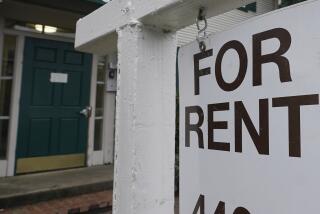S.F. Rents Climb Halfway to the Stars, if There’s a Vacancy
SAN FRANCISCO — When Leeanne Kallstrom moved back to San Francisco from New York in April, she gave her old landlord a call to see if the studio apartment and garage she had rented in the Marina district in 1992 was available.
“It was a charming studio, and I had paid $850 for it back then,” said the thirtyish Kallstrom, a saleswoman. “He told me that he was now renting the studio for $1,100, without the garage. I just laughed.”
Two months of frantic searching later, Kallstrom was no longer laughing. She had networked through friends, combed the classified ads, paid a fee to a rental agency and contacted a host of real estate agents. She watched desperate would-be renters line up at open houses to bid for filthy apartments with mold growing on their bathroom ceilings.
Kallstrom had become just one more victim of the worst rental housing crunch to hit San Francisco this decade.
“This is a very, very bad situation,” said Nancy Corsaut, a rental agent with Saxe Realty, one of the city’s largest real estate agencies.
“People seem to be moving to San Francisco not only from all over the country but from all over the world. We are getting young people earning six-figure incomes and working in San Jose who want to live in this city, where the action is, and are willing to commute an hour each way.”
As a result, available rentals that are scarce in the best of times have become as rare here as a fog-free summer’s day, Corsaut and others say.
The market is so tight that open houses produce stampedes of frazzled renters who sometimes offer landlords more than their advertised rates--despite those being 10% to 20% higher than just a year ago. Exacerbating the crunch is a recent upturn in long-moribund San Francisco housing sales.
Owners who for several years rented their properties because they could not find buyers now are putting them back up for sale, which is pushing even more renters onto the market. Another complicating factor, the agents say, was a 1994 change in the city’s rent control law, which expanded the regulation to include owner-occupied two- to four-unit buildings.
The change prompted some homeowners who were renting parts of their houses to simply stop, said James Forbes, president of Urban Properties Inc., a property management firm.
Forbes worries that the rapid upswing in rents may spark a backlash against landlords, possibly resulting in even tighter rent controls.
“I do a survey of two-bedroom apartments in San Francisco,” Forbes said. “According to my survey, we are looking at a 24% rise in rents in the past 15 months. . . . I would much rather see a gradual increase. This creates an us-and-them situation, an atmosphere of conflict between landlords and tenants, the have and the have-nots.”
Forbes, who also surveys vacancies in 14,000 professionally managed apartments, has watched the rate decline from just under 4% two years ago to just under 2% today. In all, San Francisco has 200,000 rentals.
City officials, however, are doing their best to put a good face on the race for the rentals.
“It may be bad for renters, but it is good news for the city,” said Ted Dienstfry, director of housing for Mayor Willie Brown.
Dienstfry insists it is not so much the lack of housing as the rising prices that are distressing would-be renters. Rents are up, he said, because the city is in the midst of an economic renaissance.
“For a number of years rents were constant, because in the ‘90s the city lost 30,000 jobs,” Dienstfry said. “In 1995, the city gained 5,000 new jobs, and that is good news.”
*
Because San Francisco is relatively small and highly desirable--with its myriad cultural attractions, multitude of parks, blocks of graceful, pastel-colored Victorians and the kinds of businesses that employ higher-income workers--housing here has always been at a premium, both when it comes to price and availability.
A survey released in March by M/PF Research Inc., a Dallas-based research firm, ranked San Francisco apartments as the most costly in the nation, aside from those in Manhattan.
In San Francisco, tenants were paying an average of $1,105 a month at the end of 1995--far more than the national average of $697.
But that hasn’t seemed to discourage anyone.
Corsaut said those looking for a leg up have offered her hefty tips or “finder’s fees,” in the belief that any extra incentive might just move her to slip them the address before a home is listed.
“I mean, it is not as though I’m not trying to find them a place,” Corsaut said with indignation. “But people have offered [me] $200. I tell them it is illegal.”
At least Kallstrom’s search had a happy ending.
Earlier this month, she found a studio apartment in the Marina district--minus garage. The monthly rent was $1,125.
Before selecting her, the landlord required Kallstrom to submit a resume, credit and personal references and list her past landlords. That, in addition to standard income information. Then he handed her a four-page list of dos and don’ts that even included instructions on the type of cleanser she was to use to clean the floors.
“And I’m thrilled,” Kallstrom said.
At Metro-Rent, one of the agencies that charge would-be renters a fee to receive daily updates on available apartments, houses and flats, manager John Dietz said tenants are “definitely becoming more dog-eat-dog.”
“It is not unheard of to have 50 people clamoring for applications at an open house,” Dietz said.
Dietz said he is advising clients to be “totally prepared” to sign on the dotted line whenever they look at a property, and have “a willingness to bend as far as you can on your requirements.”
That may mean taking smaller places, paying higher rents and giving up on such amenities as garages in a city where on-street parking spaces are virtually nonexistent.
“I tell them to have all their references intact, have their credit report already done, and most of all, have their checkbook ready when they go out,” Dietz said. “Beyond that, have a positive attitude when you are dealing with an owner. Stand out in a positive way, because they can pick and choose.”
And, every so often, what owners require goes beyond the norm.
In addition to the usual references, one landlord in the Marina district asked applicants to compose a poem illustrating their spiritual attachment to the district.
“It is definitely a landlord’s market, and in this kind of market some landlords take advantage,” said Joseph Preis, president of Metro-Rent.
Herb Caen, San Francisco’s legendary newspaper columnist, recently recorded the tale of a woman’s search in the Richmond district--an upscale, ethnically mixed neighborhood--for a home for herself and her son.
After finding a place that suited her, the woman offered the landlord $100 a month more than he was asking, plus a round-trip plane ticket to Europe. She was outbid.
More to Read
Inside the business of entertainment
The Wide Shot brings you news, analysis and insights on everything from streaming wars to production — and what it all means for the future.
You may occasionally receive promotional content from the Los Angeles Times.










